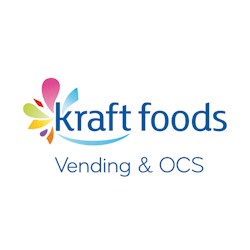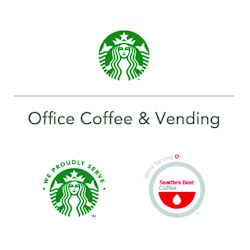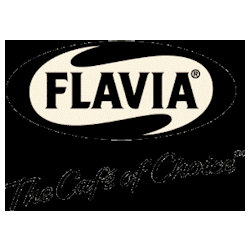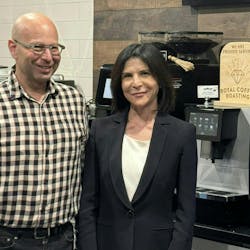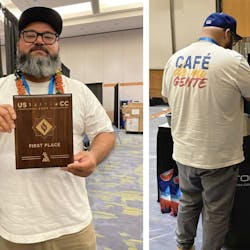Eespresso, at its simplest description, is a small shot of strong coffee. At least that is what most American consumers understand. It is, however, an incredibly complex and delicate beverage with a rich history. It has a worldwide appreciation and use and, relative to its lengthy history, is just now beginning to take the U.S. by storm. Espresso also happens to represent an incredible opportunity in the OCS industry.
What is a great shot of espresso? Many of us in the U.S. marketplace just simply do not know. It is a mystery to many. But to those who understand espresso and are part of the espresso world, it is their passion. The purpose of this article is to help the reader better understand espresso and how it fits into today’s OCS environment. But to understand espresso, we must start at the beginning.
The history of espresso begins with the story of coffee. Coffee began to spread throughout the world from the 15th century on. By 1645, the first European coffee house opened in Italy. Other countries caught on and the beverage spread quickly. Along with this new and growing interest in coffee, people began to experiment with new ways to prepare and serve coffee. Thus began a long period of innovation in the coffee industry that continues today.
ESPRESSO AND CAPPUCCINO EMERGE
Several inventions in the 1800s worked on brewing coffee faster, but it was not until 1901 when making espresso changed forever. An Italian named Luigi Bezzera patented a machine that employed steam pressure to force water through ground coffee. It brewed faster, and the resulting brew was also stronger and much better in flavor. Additionally, the steam could be used to froth milk. Espresso and cappuccino were born.
Crude by today’s standards, Bezzera’s machine produced wonderful results. However, Bezzara was not as dynamic of a sales person as he was an inventor. In 1903, the patent was sold to Desidero Pavoni, and the machine began to sell throughout Europe. In 1927, espresso landed in the U.S. where the first LaPavoni machine was installed at New York City’s Caffe Reggio by its original owner, Domenico Parisi.
In 1928, M. Cremonesi developed a piston pump that forced hot, not boiling, water through the coffee. This new process eliminated the burnt flavor and produced a smoother tasting espresso.
Click Here to view the Expresso Product Showcase in PDF format.
CREMA: HALLMARK OF ESPRESSO
In 1946, Achille Gaggia began the manufacturing
of a commercial piston machine. This machine produced an espresso that contained a layer of foam on the top of the espresso better known as the “crema.” This crema is the hallmark of a properly produced espresso. One last key development within the history of espresso is the development of the pump-based espresso machine in 1961. Launched by M. Faema, this new system forced water by use of electric pump instead of the manually
operated piston.
In terms of the U.S. consumer, espresso made its breakthrough to the mainstream through the introduction and proliferation of the coffee chain, Starbucks. Starbucks began to sell coffee and espresso-based beverages after Howard Schultz, who was inspired by espresso after a trip to Milan, Italy, purchased the company from its original owners in 1987. Starbucks has been credited for enlightening the U.S. consumer about the espresso-based beverages and true gourmet coffee.
Today, gourmet coffee represents one of the most active growth segments within the food and beverage industry. According to the 2008 National Coffee Drinking Trends, a report published by the National Coffee Association, 17 percent of the adult population consumed a gourmet beverage on a daily basis, up 3 percent from 2007.
THE ELEMENTS OF A GOOD ESPRESSO
So what makes an espresso good? First of all, good is relative — a matter of taste. What tastes good to one person may not to another. So, the more accurate question is — what does one need to make a quality shot of espresso? There is a simple recipe to follow. It is the capability and technique of the barista that makes the difference. It all starts with the coffee.
• Coffee bean — It stands to reason that a great shot of espresso can’t be made without excellent coffee. As they say — “garbage in” results in “garbage out.” With a wide selection of fantastic coffee roasters in the industry, the choices are varied. Once a bean and preferred roast is carefully selected, it must be ground perfectly and absolutely must be fresh.
• The grinder — The proper grind is key to producing a fine espresso. If the grind is too fine, the espresso will come out too slowly and over-extracted, resulting in a bitter and unpleasant shot with no crema. If the grind is too course, the espresso will under-extract and pass through the tamped coffee too quickly to pick up the proper elements. Developing this technique simply comes with practice. Also, the grinder must be maintained properly and the burrs must be kept sharp.
• The dose — The recommend amount of coffee for a single shot of espresso is 7 grams and 14 grams for a double. This is straightforward and can be measured easily.
• The tamp — This is also a technique that can only be mastered with practice. Once the coffee is ground into the portafilter, it must be tamped with about 30 pounds of pressure. If the coffee is tamped too tight, the water will pass through too slowly and over extract. If it is too loose, it will pass through too quickly and under extract.
• Water temperature and quality — The water used must be of high quality and, preferably, cold. If the water is heavy with chlorine and tastes poor, you can be sure that the espresso will not taste good. If the espresso machine is set properly, the water temperature will be 200 degrees Fahrenheit.
• Brew pressure — The espresso machine needs to apply 8 to 9 bars of brew pressure to exact espresso properly. And no, more pressure does not make better espresso.
• Extraction time — The water should pass through the coffee puck for 20 seconds for a single shot and 25 seconds for a double. Providing that the above factors are perfectly set, the resulting espresso should be ideal. Evidence of a good extraction can be viewed by watching the espresso pour from the portafilter. Watch to see if it pours too fast or too slow. If the espresso looks like warm honey pouring, the extraction is good. Others describe a proper extraction looking like a mouse tail.
• The crema — This is the moment of truth. If there is a crema that is thick, golden-brown and creamy — you’re in good shape. This is what gives espresso its complexity and depth of flavor. Technically, crema is the emulsification of water and oils. It is what gives espresso its mouth feel, density and whetting power.
A PLACE FOR ESPRESSO IN OCS?
There is no doubt that making a great shot of espresso consistently takes many hours of practice. It is a skill that must be cultivated and developed. So how can espresso possibly have any place in the OCS environment? Each office cannot hire a barista to man the espresso machine. The average office cannot afford an $8,000 espresso machine and the service costs that come with it.
One solution that has been offered is an “espresso” setting in a batch brew, single-cup machine. This is an alternate setting that utilizes a more concentrated cup of coffee. While this product will meet some customer needs, it will not be viewed as a true or traditional espresso by others.
Enter the espresso capsule/portion pack.
To solve this question, coffee machine manufacturers began to develop methods to enable one to pull a shot
of espresso within the confines of an office kitchen or executive lounge.
Early efforts produced low-quality and inconsistent espressos. The machines were still relatively expensive. Over the past three years, however, machines have been introduced that have produced nice shots of espresso with consistency and at a relatively low cost in both product and equipment. LaVazza Premium Coffees Corp., Mars Drinks North America and Nespresso have introduced espresso capsules and are finding success. Kraft Foods Inc. has also introduced its Tassimo machine that offers espresso.
The effect that this will have on the OCS market will be profound. There are two underlying factors that will define the future market of espresso in the coffee environment. The first is the continuing growth of interest in espresso from the American consumer’s point of view. With Starbucks’ success as evidence, American interest in espresso-based beverages continues to grow and that trend is not expected to slow down. The only factor that hampers this trend is economic conditions, which ultimately lends itself well to increasing interest in the OCS offerings that are typically less expensive than retail options.
OCS OFFERS AN ECONOMIC OPTION TO CONSUMERS
Offering employees the option to enjoy espresso without having to leave the office and spend $4 or $5 is not only considered a great benefit, but it also aids productivity and increases employee satisfaction. Until now, there were no viable options to high-end retail locations.
The second factor is the increasing number of European (and foreign in general) workers being infused into the U.S. workplace. As an example, Fiat, an Italian company, recently purchased a 20 percent stake in the Chrysler Corp. As more of these types of business arrangements take place, the workplace demographics will change and thus spur alterations in the tastes and interests of the overall consumer base. This indicates an increasing interest in a more diverse selection of OCS products, including espresso.
The trend of increased demand for products such
as espresso further proves that those within the OCS arena are wise to continue to find and champion products that offer quality, diversity and convenience. Especially as the current economic downturn begins to reverse, the U.S. OCS marketplace will continue to show strong demand for these products. It will pay to be ready to answer that demand.
Talking Points
* The U.S. lags behind other countries in appreciating espresso, but this is changing.
* Espresso consumers understand what makes good espresso, and they won’t accept a poor quality product.
* The espresso capsule, in conjunction with a good brewer, makes it possible to serve espresso in the office.
For more information, contact:
Kraft Vending & OCS, 800-852-9393, www.kraftvendingocs.com
LaVazza Premium Coffees Corp., 800-466-3287, www.lavazza.com
Mars Drinks North America, 877-273-5812, www.myflavia.com
Nespresso, 212-755-6978, www.nespresso.com
